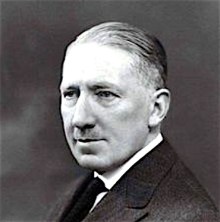
Lancelot Herman Keay [commonly known as Lancelot Keay; also known as Sir Lancelot Herman Keay] was born at 1 Clarence Villa, Enys Road, Eastbourne, Sussex, England on 3 August 1883 and studied at Brighton School of Art.
He served his articles in the architectural department of the City of Norwich and between 1906 and 1915 was Chief Architectural Assistant and subsequently the city's Architect. He oversaw the restoration of Blackfriars and St. Andrew's Hails; new Art Gallery at the Castle Museum; Observation and Discharge Wards at the Isolation Hospital; extension of Public Library; additions to City Asylum; and various housing schemes.
After serving in the Army in France and Egypt from 1916 to 1921, he worked as Architectural Assistant to the City of Birmingham until 1925, during which time he was responsible for the building of some 16,000 houses. In 1925 he was appointed Architectural Assistant to the City of Liverpool, becoming Director of Housing, and in 1938 Liverpool City Architect. It was during his time in Liverpool that Keay produced some of his most influential work, and where he gained an international reputation for his approach to municipal housing. Between 1938 and 1948 he oversaw more than 35,000 new houses in the city and its suburbs. In 1935 Keay was appointed a member of the Ministry of Health's housing advisory committee, on which he sat until 1957.
Keay was a Member of the Society of Architects (MSA). He was elected a Licentiate of the Royal Institute of British Architects (LRIBA) in 1925; a Fellow of the Royal Institute of British Architects (FRIBA) in 1929; and President of the Royal Institute of British Architects (PRIBA) in 1946-47. He was awarded a knighthood in 1947 in recognition of his services to architecture. He died in November 1974.
His address given as "Elms-Meade", Eastbourne; Oxford House, Norwich in 1914; Red House, Allerton Road, Liverpool in 1939; Chussex, Walton-on-the-Hill, Surrey in 1950; and 22 Hyde Park Gardens, Paddington, London where he died on 2 September 1974.
Ashworth, A. T. ‘Obituary: Sir Lancelot Keay, 1883-1974’ RIBA Journal vol. 82, no. 1, 1975 January, p. 9.
Directory of British Architects 1834-1914. Compiled by Antonia Brodie, et al. Volume 1: A-K. London; New York: British Architectural Library, Royal Institute of British Architects/Continuum, 2001
Harwood, Elain. Art Deco Britain: Buildings of the Interwar Years. London: Batsford, 2019
Keay, Lancelot Herman. ‘The woking man’s house’ in The Book of the Modern House. A Panoramic Survey of Contemporary Domestic Design. Edited by Patrick Abercrombie. London: Hodder & Stoughton, 1939 pp. 153-156
Whitfield, Matthew. ‘Lancelot Keay and Liverpool's Multi-Storey Housing of the 1930s’ Twentieth Century Architecture no.9, 2008 pp.30-58
Who’s Who in Architecture 1914. London: Technical Journals Ltd., 1914
‘Obituary’. Building vol. 227, 15 November 1974, p. 96